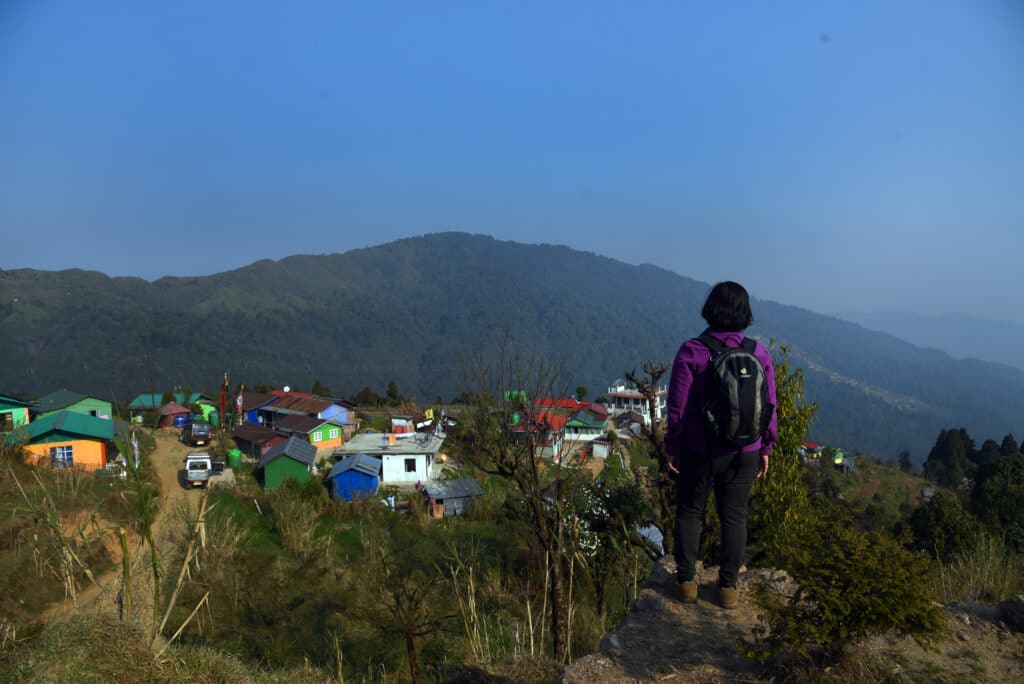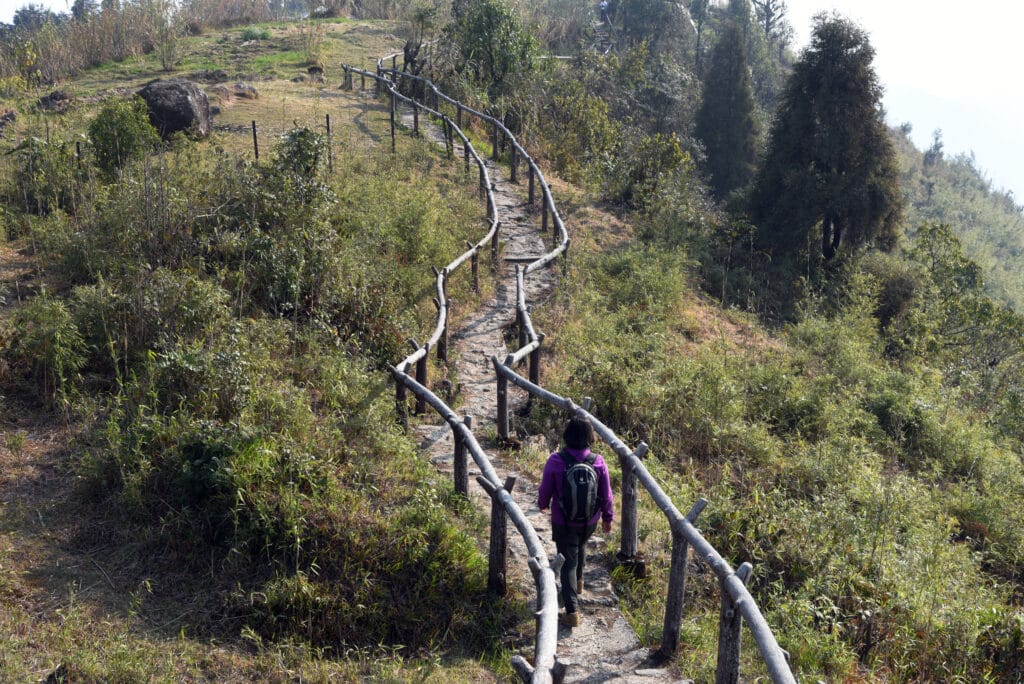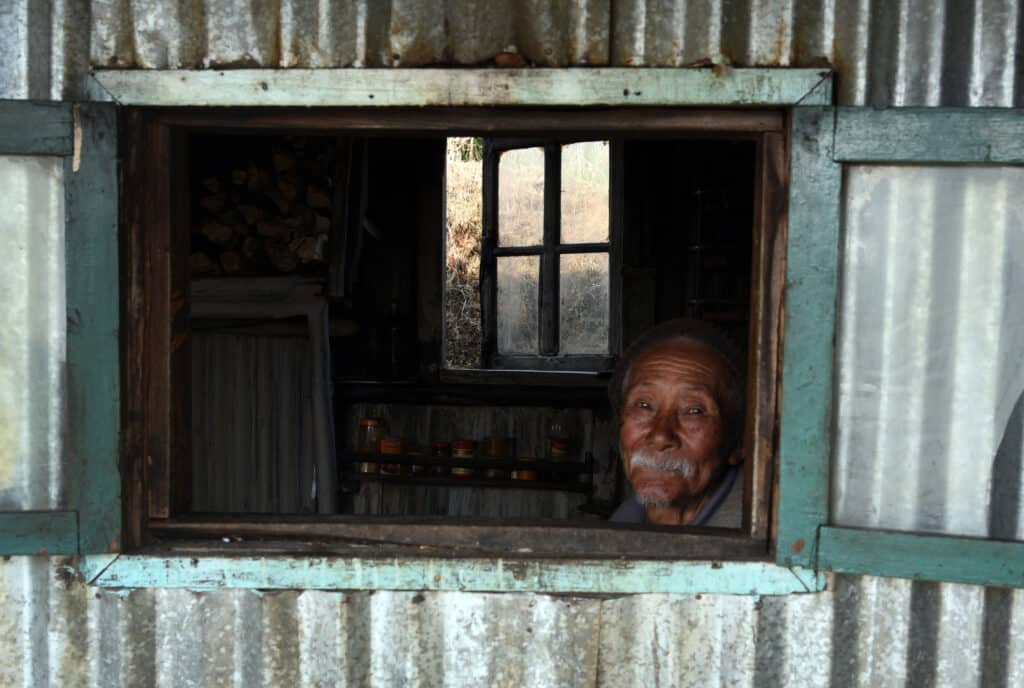Chatakpur – From a Shadowy Past to a Sustainable Future

A fog-drenched, grey morning greets us as we set out for our early morning short hike to the viewpoint, the highest point of Chatakpur. On a clear day, it offers a panoramic view of the entire village with majestic Kanchenjunga, the third highest Himalayan peak of the world at the backdrop.
An hour-long flight from Kolkata to Bagdogra, followed by a 70 km drive through lush green hills and century-old pine forests has brought us to this sleepy hamlet. Tucked deep inside the Senchal Wildlife Sanctuary, Chatakpur, at an elevation of 7887 ft., is in the Darjeeling district of West Bengal, in the northeastern part of India.
All of the 19 households of this eco-village offer homestay accommodations. The village is famous for its beautiful views of the sunrise on the mighty Himalayan range. That looks like a bleak possibility, still, we clamber up the winding stone path to discover what the pristine natural surroundings wish to offer us.
The layer of fog thins out as we get closer to the viewpoint. Perched atop a cliff, a pagoda-like structure seems to float amid the mist in the diffused glow of the morning light. Slowly we climb the stairs and heave ourselves onto an elevated platform that commands a sweeping 360 degree of the mountains surrounding us. The visibility has increased a bit. We can spot the bright colored houses peeping through the veil of fog. Each little house is of a different color. Some of them are in clusters, others stand in a solitary stance. With the thick groves of deodars, oaks and pines, hemmed with patches of farmlands and colorful houses, it seems an impressionist artist has painted his canvas with a kaleidoscope of colors.

A Warm Welcome Comes Our Way
The misty March morning allows us to enjoy tranquility almost to ourselves. Before the fog gets thicker again, we choose to descend quickly. The slippery steps slow us down and before long we find ourselves in the courtyard of a cute wooden cottage. An elderly woman with a dimpled smile welcomes us and offers us tea and noodles. She is Mona Rai, the owner of the homestay.” It looks similar to ours,” I tell her while gulping a spoonful of vegetable noodles.” Yes,” she chuckles. “We are an extended family here,” and she pauses for a moment. “It is the outcome of the Forest Department’s Initiative. All the homestays almost look alike from the outside and all provide the same facilities to the guests,” she informs genially.
Her son Binod joins us. A short, stocky man in his early thirties, Binod works as a guide here. He is passionate about birds and organic farming. “Was this village a timber smuggling den?” I repeat the same question that I asked Pema Rai, the owner of our homestay, last evening when we had gathered in their cozy and warm traditional kitchen when she was rustling up stewed pork curry, a local delicacy, for us.
“Yes, there was a lot of timber smuggling here a few years ago. But now, eco-friendly tourism is the way forward. We have promised together to protect Mother Nature and save our environment.” Mona shakes my hand, and her warm smile spreads a positive vibe.

Following the Road Less Traveled
Now it is quite clear outside. Binod agrees to accompany us to Kalipokhri, a small waterbody where the villagers offer prayers. It is deep inside the Senchal sanctuary. This forest trail is less traveled by tourists. The narrow road meanders through the ancient, moss-covered pine trees. The songs of crickets and the chirping of birds are our constant companions. A woody fragrance refreshes our souls as we arrive at the waterbody, the multicolored prayer flags adding beauty to the haunting charm and eerie silence of the forest. Binod helps us to spot some colorful winged guests. “It is a paradise for birders,” he informs, as we head back towards the village. “You can find Warbler, Flycatcher, Blue Magpie, Pipit, Long Tail Shrike and plenty of other birds here,” he tells us excitedly. We are at the entrance of the village now. Binod takes his leave near the Forest Rest House.
A Sustainable Future Emerges
We retrace our steps towards Chatakpur. The forest track twists and turns through the green fields and colorful cottages decorated elegantly with seasonal flowers. Village children run playfully up and down the road. It is pre-harvest season and we spot men and women busy in the farmlands. Some of the tourists are also helping the villagers in the farming. Others are engaged in leisurely conversations with elderly villagers on the terraces of the cottages. It is a happy scene of a world that has largely gone by, laced with a cozy, laidback charm, where the residents of a Himalayan village are collectively building up a sustainable future.
Cover: Chatakpur Moves toward sustainability through eco-travel. Photo by Bandita Mukherjee
Click Search and Book Accommodations in Chatakpur

A Kolkata-based teacher, Bandita Mukherjee is an avid traveller. In her pursuit to dig deep into the diverse landscapes, cultures and customs, she has visited 18 countries and counting. But while she is thrilled to hike unknown terrains, explore cities steeped in history and understand the culinary scene of every new place she travels into; the nuanced textures of her native India is what she finds most exciting as a compulsive traveller. When she is not teaching or on-the-go, she can be found making her next trip plans, with a mug of fresh Darjeeling tea and her pet cat curled up by her side.